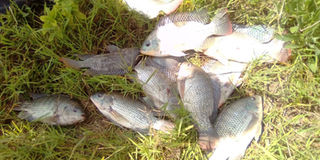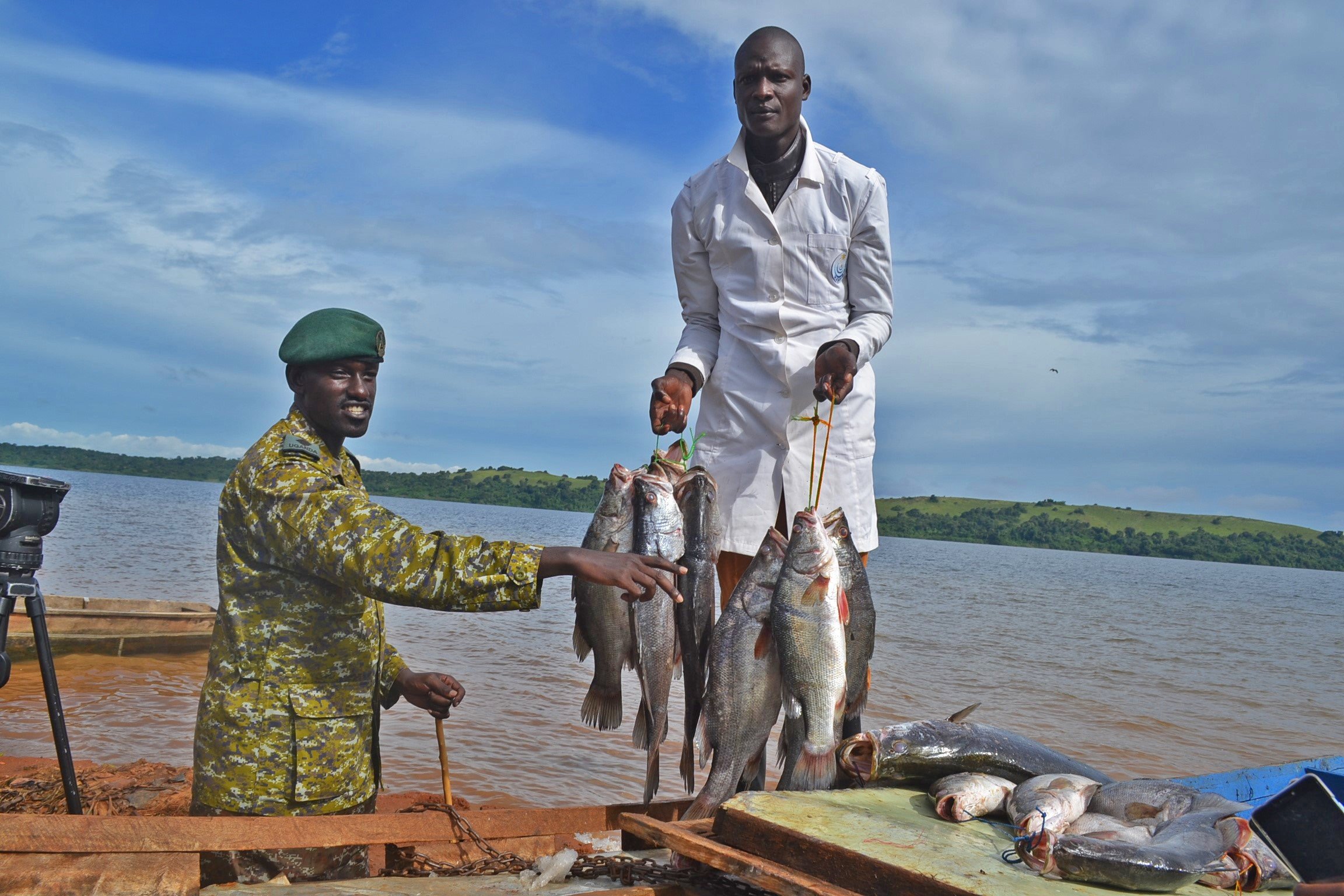How govt is reviving the fishing sector

Tilapia from a fish pond at Ngetta ZARDI in Lira District.
What you need to know:
It is training stakeholders on best fish farming practices that generate income and are ecologically friendly
The government has embarked on several measures aimed at fostering sustainable fisheries and aquaculture sub-sectors.
It seeks to increase fish stock production, create jobs, and ensure an environmentally sustainable and climate-resilient agriculture sector through interventions such as promoting commercial farming and creating tighter laws on illegal fishing and utilisation of environment and water-related resources .
Already, ministries, agencies, departments, and development partners have started building farmers’ capacity to invest in fish farming.
Mr Richard Musota, the team leader for Upper Nile Management Zone at the Ministry of Water and Environment, told Daily Monitor on Wednesday that they have set up a demonstration centre for capacity building on fish farming at Ngetta Zonal Agriculture Research and Development Institute (Ngetta ZARDI) in Lira City.
“The ministry established 17 fish ponds at Ngetta ZARDI in Lira as demonstration plots for training stakeholders on fish farming as the best practices on income generating activities that should be promoted along the wetlands and buffer zones of the river systems to conserve water resources,” Mr Musota said.
“So far, two ponds have been stocked with 2,500 tilapia and 6,000 catfish species,” he added.
The initiative is being implemented under the Directorate of Water Resources Management through the EURECCCA project in collaboration with the National Agricultural Research Organisation . EURECCA stands for enhancing the resilience of communities to climate change through catchment-based integrated management of water and related resources in Uganda.
Dr Laban Turyagyenda, the director of Ngetta ZARDI, said during the dry season, communities search for fish in swamps, which destroys the environment.
“When you go there (swamps), you think they (residents) are digging for gold, yet they are hunting for fish. So, we want to see if we can have fish farming as a way of conserving our wetlands,” he said.
According to the Food and Agriculture Organisation (FAO), one of the most pressing challenges facing food systems in Africa is ensuring the availability of a healthy and sustainable diet to 2.4 billion people by 2050.
The UN agency notes that in Africa’s food systems, fish and other aquatic foods play a multifaceted role in generating income and providing a critical source of essential micronutrients.
While meeting leaders from Acholi and Lango sub-regions in Otuke District on June 11, President Museveni warned farmers against growing rice in swamps since the activity destroys the environment. He instead advised them to resort to fish farming because it is environmentally friendly.
According to the State of World Fisheries and Aquaculture published on June 29, sustainable aquaculture development remains critical to supply the growing demand for aquatic foods.
“Effective fisheries management has been proven to successfully rebuild stocks and increase catches within ecosystem boundaries. Improving global fisheries management remains crucial to restore ecosystems to a healthy and productive state and protect the long-term supply of aquatic foods,” the report states.
Fisheries and aquaculture production globally reached a record 214 million tonnes in 2020, comprising 178 million tonnes of aquatic animals and 36 million tonnes of algae, largely due to the growth of aquaculture, particularly in Asia.
According to the Agriculture ministry, fish is the second non-traditional export earner of the economy.
The ministry is training fishing communities and giving them inputs so as to manage economically viable and sustainable interventions.
With support from development partners, the government is also promoting legal fishing methods and gear, efficient post-harvest handling and value addition technologies.
It has also invested in aqua parks in Apac and Kalangala districts to boost fish harvests. The Ministry of Finance secured a grant of €10 million (about Shs46b) from the European Union for the construction of the aqua-parks.
The Apac fish project is expected to create 400 jobs, according to the Ministry of Agriculture.
The project, with an investment portfolio of Shs6.3b, sits on 556 acres in Onekgwok and Teboke villages, Tarogali Parish in Ibuje Sub-county.
The government hired a local contractor – Hardscreen Logistics Ltd – to design and build the aqua park.
Mr Paul Omanyi, the project coordinator for Apac and Kalangala aqua-parks, said under the first phase, at least 81 fish ponds with production capacity of 2,000 tonnes per cycle of six months will be constructed in Apac.
An ice plant with a capacity of 70 tonnes per day, and a multi-species hatchery of five million fingerlings per cycle per month will also be constructed. “One fish pond will be one acre, and others will be 0.5 and 0.2 acres,” Mr Omanyi added.
The Kalangala fish hatchery project at Mwena in Kalangala Town Council is expected to boost modern fish farming and create jobs for youth.
“We are going to install 80 cages. The smallest are 6 metres by 6 metres and 16 diametre cages,” Mr Omanyi told Daily Monitor on Tuesday.
The fish projects are being implemented under the of Promoting Environmentally Sustainable Commercial Aquaculture in Uganda programme.
The government has also supported private investments in the fishing sector. Farms have been established on land leased from the government or locally purchased land.
Some of the investments include Lake Harvest in Jinja, Yalelo Uganda on Lake Victoria, Victoria Treasures, which has 140 cages in Lake Victoria and IG Invest Uganda Ltd in Buikwe District.
“These private cage farmers are importing feeds, on average 20 containers of 40 ft containers and this is a loss to the country because of lack of reliable high quality feeds,” Mr Omanyi said.
Also, the FAO together with the Ministry of Agriculture launched a technical cooperation project in fishing communities around Lake Victoria on January 30, 2019. The pilot project, dubbed Integrated Livelihood Support to Fishing Communities around Lake Victoria, targets women and youth groups in rural poor fishing communities in Kalangala, Kalungu and Masaka districts.
The government has also introduced several reforms to address the challenges facing the fishing sector.
These include regulating the number of fishing vessels and gear, instituting restrictive licence fees, and intensified monitoring, control and surveillance of fisheries activities.
Livelihood concerns
Mr Vincent Ssempijja, the former Minister of Agriculture, said while these strategies have yielded positive results, some of them have led to exclusion of fishermen and could lead to increased risk of loss of livelihoods.
Mr Ssempijja called for alternative livelihoods for fishing-dependent communities in Mayuge, Namayingo, Masaka and Kalangala, where majority of the affected are women and youth.
Dr Callist Tindimugaya, the commissioner for Water Resources Planning and Regulations at the Ministry of Water and Environment, last year urged all stakeholders to play their part.
“All stakeholders, including politicians, religious and cultural leaders need to coordinate their efforts in the fight against climate change– and civil society should be part of the equation,” Dr Tindimugaya said.
There are also emerging issues in the regulation and management of the fisheries sub-sector, which are not addressed under the Fish Act of 2000 Cap 197.
These include overcapacity, invasion of water bodies by aquatic weeds, limited support and investments in aquaculture, institutional challenges, excessive fishing pressure, destructive fishing malpractices, growth in illicit trade in immature fish, and decreasing per capita fish consumption.
However, the proposed Fisheries and Aquaculture Bill, 2021 seeks to address some of these challenges and foster sustainable fisheries and aquaculture subsectors.
FISH SECTOR AT A GLANCE
According to FAO, Uganda is the second largest aquaculture producer in Sub-Saharan Africa after Nigeria. The agency notes that aquaculture production in the country increased from just 800 tonnes in 2000 to 103,700 tonnes in 2019. Production was mostly composed of Nile tilapia (69 percent) and catfishes (30 percent). “It is estimated that 153,000 Ugandans were involved in fisheries and aquaculture in 2019, of which 124,800 were engaged in inland fishing and 28,236 in fish farming. Large quantities of smoked and sun-dried fish originating from Lake Victoria are traded, legally and illegally, into western Uganda and in the DR Congo,” FAO stated. The annual per capita consumption of fish was estimated at about 11.2kg in 2016. Consumers generally prefer fresh fish, but smoking, sun-drying and salting by artisanal processors (many of whom are women) is done to prolong shelf-life.




